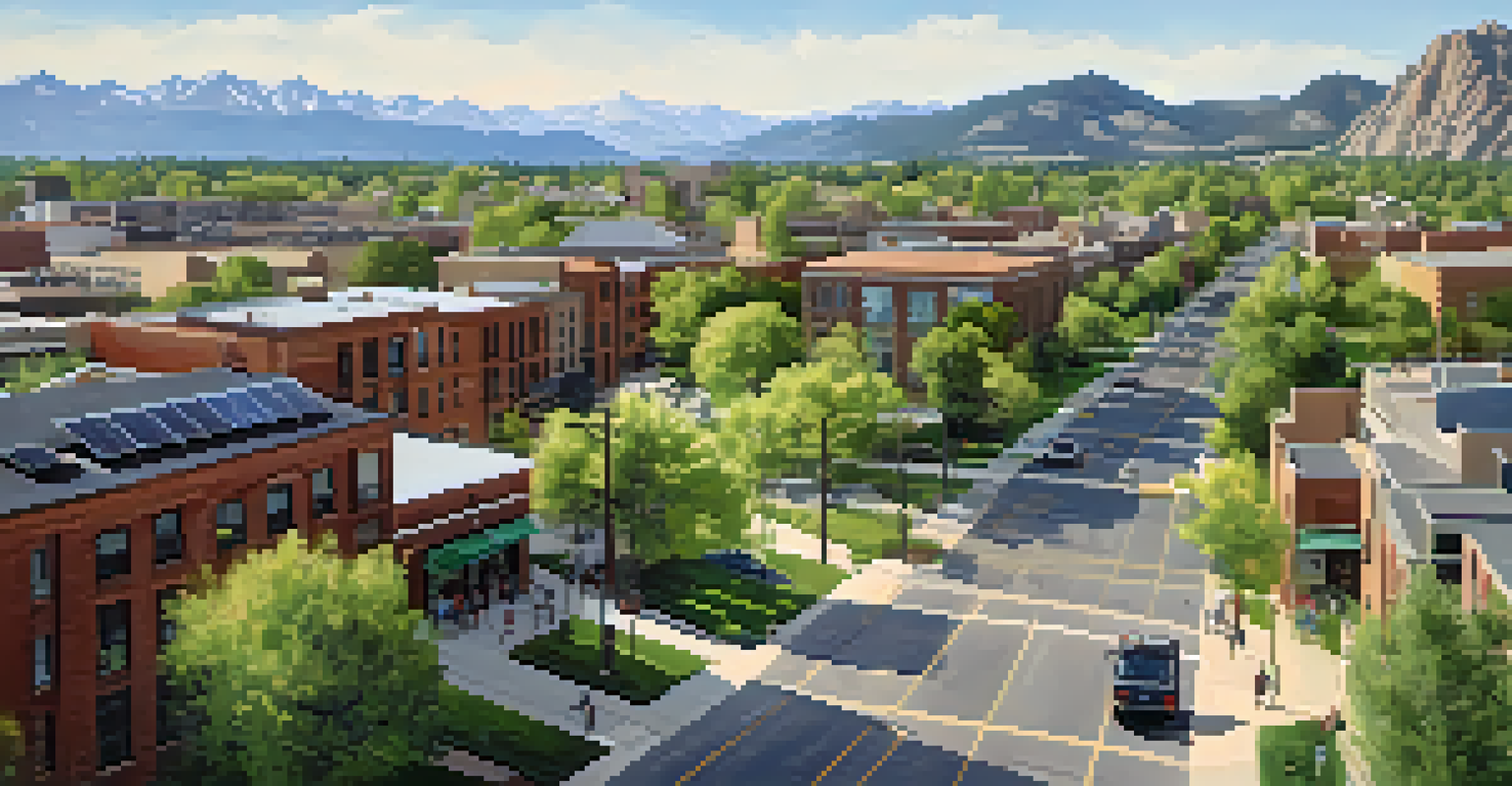Boulder's Environmental Movement: A Historical Perspective

Early Environmental Consciousness in Boulder
Boulder's environmental movement has roots that extend back to the early 20th century. During this time, citizens began to recognize the importance of preserving natural spaces and resources. The formation of local conservation groups highlighted the growing awareness of environmental issues, setting the stage for future activism. This early consciousness laid the groundwork for what would become a vibrant community dedicated to environmental stewardship.
The environment is where we all meet; where we all have a mutual interest; it is the one thing all of us share.
As the population grew, so did the challenges facing Boulder's natural beauty. Issues like pollution and urban sprawl prompted residents to rally for change. The establishment of parks and open spaces became a priority for local leaders, reflecting the community's commitment to maintaining a balance between development and nature. These initial efforts showcased the collective desire to protect Boulder's unique landscape.
With a foundation of community engagement, Boulder began to embrace a more organized approach to environmentalism. Residents started to participate in local government meetings, advocating for policies that would safeguard their beloved surroundings. This period marked the beginning of a more formalized environmental movement, one that would gain momentum in the decades to come.
The 1960s: A Catalyst for Change
The 1960s proved to be a pivotal decade for Boulder's environmental movement. Nationally, the rise of the environmental movement was fueled by growing awareness of pollution and conservation, and Boulder was no exception. Local activists began to organize around critical issues such as water quality, air pollution, and the preservation of open spaces. This era saw the emergence of grassroots campaigns that sought to protect Boulder's natural resources.

One notable event was the establishment of the Boulder Open Space program in 1967, which aimed to preserve the city's scenic landscapes. This initiative garnered widespread community support and demonstrated the power of collective action. Citizens recognized the need for sustainable land management practices, inspiring a new generation of environmental advocates. The success of the Open Space program became a model for other cities looking to prioritize conservation.
Boulder's Early Environmental Roots
The environmental movement in Boulder began in the early 20th century, driven by a community commitment to preserving natural spaces and resources.
As the environmental movement gained traction, Boulder's residents began to advocate for more comprehensive policies addressing climate change and sustainability. Activists worked tirelessly to bring awareness to the interconnectedness of local and global environmental issues. The 1960s set the stage for a broader understanding of environmentalism, shaping the community's values and priorities for years to come.
The 1970s: Institutionalizing Environmental Advocacy
The 1970s marked a significant shift in how Boulder approached environmental issues, with the establishment of dedicated organizations and initiatives. The city's commitment to sustainability led to the creation of the Boulder Environmental Affairs Department in 1971. This department sought to integrate environmental considerations into local government policies, emphasizing the importance of sustainable development.
We won't have a society if we destroy the environment.
Throughout the decade, major legislation such as the Clean Air Act and the Clean Water Act galvanized residents to advocate for stronger regulations. Boulder became a beacon of environmental activism, drawing attention to the need for robust protections against pollution and habitat destruction. This newfound institutional support allowed local groups to flourish, amplifying their voices in the fight for environmental justice.
Community events such as Earth Day celebrations became increasingly popular in Boulder during the 1970s, fostering a sense of unity among residents. These gatherings not only educated the public about environmental issues but also inspired a spirit of activism. The decade's focus on institutionalizing environmental advocacy laid the groundwork for future generations to continue the fight for a sustainable future.
The 1980s: Expanding the Environmental Agenda
As the 1980s rolled in, Boulder's environmental movement began to broaden its focus beyond local issues to address global challenges. Activists became increasingly aware of the interconnectedness of environmental problems, advocating for solutions that considered both local and global contexts. The rise of the international environmental movement, highlighted by events such as the 1987 Montreal Protocol, influenced Boulder's own initiatives.
During this time, the city implemented a number of innovative programs aimed at promoting sustainability. Efforts to encourage recycling and reduce waste gained momentum, positioning Boulder as a leader in environmental practices. The community rallied around new ideas, such as energy efficiency and renewable energy sources, reflecting a growing commitment to combat climate change.
1960s: Grassroots Activism Emerges
The 1960s marked a pivotal moment as residents organized around critical environmental issues, leading to the establishment of the Boulder Open Space program.
Additionally, the 1980s saw the establishment of various environmental education programs for schools and community organizations. These initiatives aimed to empower residents with knowledge about ecological issues and inspire them to take action. By fostering a culture of environmental awareness, Boulder continued to build on its legacy as a city dedicated to protecting the planet.
The 1990s: A New Era of Environmental Innovation
The 1990s ushered in a wave of environmental innovation in Boulder, as the city began to implement groundbreaking policies and practices. This decade was characterized by a collaborative approach, involving local government, businesses, and community members in environmental initiatives. The establishment of the Boulder Climate Action Plan in 1995 demonstrated the city's commitment to addressing climate change through measurable goals.
Boulder's focus on sustainable transportation options gained traction during the 1990s. Initiatives such as the expansion of public transit and the promotion of biking and walking created a more environmentally friendly urban landscape. These efforts not only reduced carbon emissions but also fostered a sense of community among residents who embraced alternative modes of transportation.
Moreover, the 1990s saw the rise of local organic farming and sustainable agriculture practices. Farmers' markets gained popularity, connecting consumers directly with local producers and emphasizing the importance of supporting sustainable food systems. This shift in food culture further solidified Boulder's identity as a hub for environmental consciousness and innovation.
The 2000s: Embracing Sustainability in Everyday Life
Entering the 2000s, Boulder continued to embrace sustainability as a core value woven into the fabric of daily life. The city implemented several green building initiatives, encouraging environmentally friendly construction practices. Programs such as the Green Points system incentivized builders to incorporate sustainable features into their projects, showcasing Boulder's commitment to reducing its ecological footprint.
In addition to building practices, Boulder's residents became increasingly engaged in local environmental issues. Community-led initiatives focused on reducing waste, conserving water, and protecting natural habitats. The rise of urban gardening and permaculture reflected a growing awareness of the importance of local food production and biodiversity.
Ongoing Commitment to Sustainability
Boulder's environmental movement continues to evolve, focusing on ambitious climate action and community engagement to achieve sustainability.
The city also prioritized renewable energy, launching programs that encouraged residents to invest in solar power. Community solar gardens emerged, allowing those without suitable rooftops to participate in clean energy initiatives. This collective push for sustainability in everyday life highlighted Boulder's dedication to creating a greener, more resilient future.
The 2010s and Beyond: A Continued Commitment
As we moved into the 2010s, Boulder's environmental movement continued to evolve, adapting to new challenges and opportunities. The city remained at the forefront of climate action, implementing ambitious goals to achieve carbon neutrality. Initiatives aimed at reducing greenhouse gas emissions and promoting sustainability in all aspects of life became central to Boulder's identity.
Community engagement remained a hallmark of Boulder's approach to environmentalism. Residents actively participated in discussions about land use, transportation, and energy policies, ensuring that diverse voices were heard. Collaborative efforts between local organizations and government entities fostered a culture of transparency, accountability, and shared responsibility for protecting the environment.

Looking ahead, Boulder stands as a model for other communities striving to balance growth with environmental preservation. The city's rich history of activism and innovation serves as a testament to the power of collective action. As new generations of environmental advocates emerge, Boulder's commitment to sustainability will undoubtedly continue to inspire positive change both locally and globally.